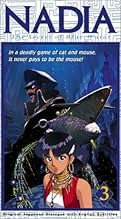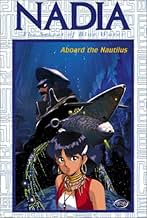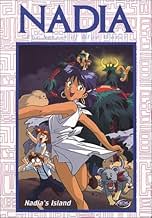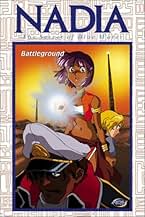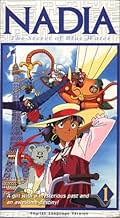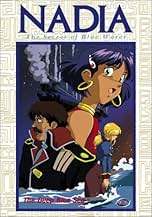AVALIAÇÃO DA IMDb
7,7/10
2,2 mil
SUA AVALIAÇÃO
Adicionar um enredo no seu idiomaA teen acrobat of mysterious origins and a young inventor find themselves entangled in a sinister plot that involves the fate of the world.A teen acrobat of mysterious origins and a young inventor find themselves entangled in a sinister plot that involves the fate of the world.A teen acrobat of mysterious origins and a young inventor find themselves entangled in a sinister plot that involves the fate of the world.
Explorar episódios
Avaliações em destaque
"Nadia: the Secret of Blue Water" (originally called "Fushigi no umi no Nadia", literally translating "Nadia of the Mysterious Seas") is 39 episodes long anime series, which was originally aired in the years 1990-1991. Series primary director was Hideaki Anno, who had previously worked as one of the animators in Hayao Miyazaki's film "Nausicaa of the Valley of the Wind" (1984) and who would later direct one of the most successful anime series ever; "Neon Genesis Evangelion" (1995-1996). The story of the series has been inspired by the novels of Jules Verne, especially "20.000 Leagues Under the Sea" (1870). Also Miyazaki's film "Laputa- Castle in the Sky" (1986) has inspired some elements of the story.
Set in the year of 1890, Nadia, an orphaned acrobat girl working in circus, is trying to find a way to get to Africa to look her possible family and origins. While coming to Paris to perform, she is chased by a very Team Rocket- like gang of thieves, who try to steal "Blue Water", a mysterious blue stone Nadia is wearing around her neck. She is helped by Jean, a young inventor boy, who out of good heart decides to help Nadia to get to Africa. While trying to avoid any more contacts with the thieves, Nadia and Jean find themselves in the middle of a secret war between Captain Nemo, a mysterious scientist who lives in his submarine "Nautilus" with his crew, and Gargoyle, a power-mad masked villain. Just what is the secret of "Blue Water" and what is the connection of Nadia to both Nemo and Gargoyle?
When I watched the series I was already well passed the age when the animations with good guys vs. evil world dominating villains were interesting. Yet, "Nadia" is not as simple as it may first look like. The characters are not just two-dimensional but have some real life in them. Especially Nadia's character; who first appears as temperamental and distrusting, but learns to become caring and what she most values in her life, when she nearly looses all. Also, her relationship with Jean is very realistic for a change. Music is captivating and the story telling dynamic. The animation itself is not the best possible quality but it really doesn't bother. Voice actors (I'm talking the original Japanese ones, for I have not heard either of the two English dubs) are doing a great job. Noriko Hidaka (who has done such great anime roles as Akane in "Ranma 1/2", Kikyo in "Inuyasha" and Near in "Death Note") really convinced me that she was voicing a 14 year old boy; Jean. Yoshino Takamori did a great job with temperamental but caring Nadia and Motomu Kiyokawa (Walter in both "Hellsing" and "Hellsing OVA" series) was absolutely chilling as Gargoyle.
Sadly, series does have one terrible down side to it: the filler episodes directed by Shinji Higuchi, that for some unclear reason were demanded in the middle of the series. During those episodes story hardly moved at all, characters loose their interest and almost every minute is spend with some of the worst anime humor ever. These filler episodes are episodes 23-29 and 32-34. Episodes 30-31 are worth seeing for the story actually moves there somewhat and the relationship of Nadia and Jean strengthens there.
If you can forgive some simple animation, unbelievable plot twists and skip the previously mentioned filler episodes, then you have a great and entertaining anime series here, that will keep you interested from the beginning to the end. Warmly recommended.
Set in the year of 1890, Nadia, an orphaned acrobat girl working in circus, is trying to find a way to get to Africa to look her possible family and origins. While coming to Paris to perform, she is chased by a very Team Rocket- like gang of thieves, who try to steal "Blue Water", a mysterious blue stone Nadia is wearing around her neck. She is helped by Jean, a young inventor boy, who out of good heart decides to help Nadia to get to Africa. While trying to avoid any more contacts with the thieves, Nadia and Jean find themselves in the middle of a secret war between Captain Nemo, a mysterious scientist who lives in his submarine "Nautilus" with his crew, and Gargoyle, a power-mad masked villain. Just what is the secret of "Blue Water" and what is the connection of Nadia to both Nemo and Gargoyle?
When I watched the series I was already well passed the age when the animations with good guys vs. evil world dominating villains were interesting. Yet, "Nadia" is not as simple as it may first look like. The characters are not just two-dimensional but have some real life in them. Especially Nadia's character; who first appears as temperamental and distrusting, but learns to become caring and what she most values in her life, when she nearly looses all. Also, her relationship with Jean is very realistic for a change. Music is captivating and the story telling dynamic. The animation itself is not the best possible quality but it really doesn't bother. Voice actors (I'm talking the original Japanese ones, for I have not heard either of the two English dubs) are doing a great job. Noriko Hidaka (who has done such great anime roles as Akane in "Ranma 1/2", Kikyo in "Inuyasha" and Near in "Death Note") really convinced me that she was voicing a 14 year old boy; Jean. Yoshino Takamori did a great job with temperamental but caring Nadia and Motomu Kiyokawa (Walter in both "Hellsing" and "Hellsing OVA" series) was absolutely chilling as Gargoyle.
Sadly, series does have one terrible down side to it: the filler episodes directed by Shinji Higuchi, that for some unclear reason were demanded in the middle of the series. During those episodes story hardly moved at all, characters loose their interest and almost every minute is spend with some of the worst anime humor ever. These filler episodes are episodes 23-29 and 32-34. Episodes 30-31 are worth seeing for the story actually moves there somewhat and the relationship of Nadia and Jean strengthens there.
If you can forgive some simple animation, unbelievable plot twists and skip the previously mentioned filler episodes, then you have a great and entertaining anime series here, that will keep you interested from the beginning to the end. Warmly recommended.
A few years back, Disney announced they were going to be dubbing and releasing major Japanese anime in the US. So far, KIKI'S DELIVERY SERVICE and PRINCESS MONONOKE have been the only ones to make it. It's dang obvious though, that someone at Disney watched NADIA and took notes, because the character design of the Atlantean girl in ATLANTIS looks to have been lifted directly from here.
US release of the dubbed NADIA stalled at an early section on the series. I hope that the release of ATLANTIS prompts someone to complete the US release of NADIA, as I would like to finally understand what the heck I watched a decade ago in Japanese!
US release of the dubbed NADIA stalled at an early section on the series. I hope that the release of ATLANTIS prompts someone to complete the US release of NADIA, as I would like to finally understand what the heck I watched a decade ago in Japanese!
Set in Pairs, France 1889, young inventor, Jean Roque Lartigue while showing off his latest aircraft at the Parisian Exposition comes across young orphaned dark skinned circus performer Nadia and her pet lion, King and becomes smitten with her. Jean by chance encounter helps Nadia elude Grandis Granva and her two henchman Sanson and Hanson who desire a jewel in Nadia's possession known as the Blue Water. While Nadia is reluctant to accept Jean's help and friendship the two eventually form a bond and begin traveling via Jean's unreliable aircraft in search of both Jean's missing father and Nadia's missing past. Along the way the two join up with Captain Nemo and his crew on board the submarine, The Nautilus, as Nemo and his crew fight against an enigmatic villains known as the Neo Atlanteans headed by equally mysterious Lord Gargoyle who plan to use extraordinary technology to take over the world.
Running for 39 episodes from 1990 to 1991, Nadia: The Secret of Blue Water's origins go back to the 1970s when the show began as an outline by none other than Hayao Miyazaki. Miyazaki's outline then titled Around the World Under the Sea took heavy influence from Jules Verne particularly 20,000 Leagues Under the Sea, and whole the project was never made, elements were reused in Miyazaki's subsequent works such as Future Boy Conan and Castle in the Sky. Gainax after being approached by Toho to produce a show for NHK, the staff of Gainax came across Miyazaki's outline and became captivated by it. Production on the show was tumultuous with Hideaki Anno often working as much as 18 hours a day trying to get the show done and having Shinji Higuchi to take over the direction from episodes 23 to 34 while Anno worked and finishing the final five episodes (which lead to the infamous "island episodes").
Viewing Nadia: The Secret of Blue Water is an experience. What starts out as a high adventure science-fantasy inspired by the works of Jules Verne soon moves to the background as the show shifts focus to analysis of characters and relationships with the main plot used more as a bridge for transitioning and exploring these character moments. The primary storyline of the show with the instigating mysteries of Nadia's origins or Jean's search for his father lost at sea are often relegated to the background as we see Nadia and Jean explore their characters in interactions with various side characters both major and minor we meet throughout the show. While the tone of the show starts out fairly light and optimistic, the show gets progressively darker (for the most part, but we'll get to that) with Nadia's search for answers to who and what she is often leaving her more lost than before and Jean's love of science and engineering challenged as he sees the darker side of scientific prowess used for conquest and murder.
The show feels like it's the product of two clashing visions as episodes such as "Run, Marie, Run!" have that childlike whimsy that characterizes much of Miyazaki's work with the focus of the episode being the youngest character Marie who spends much of the episode frolicking and playing with no real sense of direction plotwise until the final third, then other episodes are more indicative of Anno's work with The Mystery of the Lost Continent containing many scenes wherein Nadia tries to understand her feelings by talking to character based representations of her thoughts, fears and insecurities in a way that's not too dissimilar to how Anno approach such topics with the character of Shinji Ikari in Evangelion. Much like Shinji, the show makes it very hard to sympathize with Nadia as her personality is confrontational to a fault taking a dour view of killing anything for any reason be it hunting for meat or even killing in self-defense. It's not like there isn't ground to be explored in topics like this but Nadia's rationale regarding her stance on these issues never goes beyond "killing is wrong because it's wrong" and the show keeps coming back to it in one shape or another with not much in the way of development beyond the initial iteration of the point. Much like Shinji from Evangelion, Nadia's arc for her character boils down to the "hedgehog's dilemma" with Nadia gradually lowering her defenses and allowing for emotional and romantic intimacy between herself and Jean
The show is unfortunately undercut in quality with 12 episode batch from episode 23-34 known as the Island/Africa arc episodes. Overseen by Shinji Higuchi after Anno stepped aside to fine tune the final five episodes to wrap up the storyline and born from an executive mandate from NHK to expand the series run following its initial success, the batch of episodes not only feel regressive in terms of story and character following the revelations from episode 22 (which is seen as the best episode of the series by many) but the fact that NHK refused to shell out the money lead to a noticeable drop in quality as these episodes were farmed out to a third party Korean animation studio. Not only is the animation awful, but calls attention to how far it's dropped in quality with frequent flashbacks to the previous 22 episodes which meshes with the new footage the same way a mash-up of the London Symphony Orchestra alongside a bunch of kids playing the Oscar Mayer Weiner song on kazoos. I cannot stress enough how bad the island/Africa arc is, as its slapstick heavy approach that removes the high adventure and replacing it with what feels like a demented take of Gilligan's Island. There are individual salvageable moments of character and wonder in these island episodes and the episodes 30 and 31 are easily the strongest of this run and come close to the standard set in the previous 22 episodes (albeit with many issues keeping it from complete success). When we get to the final arc as scripted by Anno the course correction is nothing short of miraculous. While the show still needs to carry over plot points from the island arc it mostly disregards much of the petty unimportant squabbling that made up the majority of the island arc with only the plot points from episodes 30 and 31 being called back to. Episodes 35-39 of Nadia: Secret of Blue Water are basically a proto take on themes and points that would be revisited and expanded upon in Gainax's follow-up projects like FLCL, Gurenn Lagann, and of course Evangelion whose concept was salvage from a scrapped Nadia sequel after Gainax couldn't obtain the rights from NHK.
Nadia: The Secret of Blue Water has a complicated legacy. While it laid the groundwork for subsequent works that would serve as industry benchmarks of the anime industry, the show itself has flaws that are hard to ignore. With nearly 33% of the show's run taken up by the abysmal Island Arc, Nadia's filtering of Miyazaki by way of Anno with a substandard patch job by executive mandated filler material is a rollercoaster in quality with highs and lows. There's definitely more highs than lows in Nadia, but the lows burn a lot of good will established in the series, however despite possessing a terrible run of episodes in its middle section, the series is saved with one of the most amazing final act course corrections that serves as a refreshing break from a show faltering at the end and instead giving us some of its best material. While the series itself is a mixed bag that doesn't come together as well as it should, as a historical curiosity Nadia's influences be seen to have had a lasting impression.
Running for 39 episodes from 1990 to 1991, Nadia: The Secret of Blue Water's origins go back to the 1970s when the show began as an outline by none other than Hayao Miyazaki. Miyazaki's outline then titled Around the World Under the Sea took heavy influence from Jules Verne particularly 20,000 Leagues Under the Sea, and whole the project was never made, elements were reused in Miyazaki's subsequent works such as Future Boy Conan and Castle in the Sky. Gainax after being approached by Toho to produce a show for NHK, the staff of Gainax came across Miyazaki's outline and became captivated by it. Production on the show was tumultuous with Hideaki Anno often working as much as 18 hours a day trying to get the show done and having Shinji Higuchi to take over the direction from episodes 23 to 34 while Anno worked and finishing the final five episodes (which lead to the infamous "island episodes").
Viewing Nadia: The Secret of Blue Water is an experience. What starts out as a high adventure science-fantasy inspired by the works of Jules Verne soon moves to the background as the show shifts focus to analysis of characters and relationships with the main plot used more as a bridge for transitioning and exploring these character moments. The primary storyline of the show with the instigating mysteries of Nadia's origins or Jean's search for his father lost at sea are often relegated to the background as we see Nadia and Jean explore their characters in interactions with various side characters both major and minor we meet throughout the show. While the tone of the show starts out fairly light and optimistic, the show gets progressively darker (for the most part, but we'll get to that) with Nadia's search for answers to who and what she is often leaving her more lost than before and Jean's love of science and engineering challenged as he sees the darker side of scientific prowess used for conquest and murder.
The show feels like it's the product of two clashing visions as episodes such as "Run, Marie, Run!" have that childlike whimsy that characterizes much of Miyazaki's work with the focus of the episode being the youngest character Marie who spends much of the episode frolicking and playing with no real sense of direction plotwise until the final third, then other episodes are more indicative of Anno's work with The Mystery of the Lost Continent containing many scenes wherein Nadia tries to understand her feelings by talking to character based representations of her thoughts, fears and insecurities in a way that's not too dissimilar to how Anno approach such topics with the character of Shinji Ikari in Evangelion. Much like Shinji, the show makes it very hard to sympathize with Nadia as her personality is confrontational to a fault taking a dour view of killing anything for any reason be it hunting for meat or even killing in self-defense. It's not like there isn't ground to be explored in topics like this but Nadia's rationale regarding her stance on these issues never goes beyond "killing is wrong because it's wrong" and the show keeps coming back to it in one shape or another with not much in the way of development beyond the initial iteration of the point. Much like Shinji from Evangelion, Nadia's arc for her character boils down to the "hedgehog's dilemma" with Nadia gradually lowering her defenses and allowing for emotional and romantic intimacy between herself and Jean
The show is unfortunately undercut in quality with 12 episode batch from episode 23-34 known as the Island/Africa arc episodes. Overseen by Shinji Higuchi after Anno stepped aside to fine tune the final five episodes to wrap up the storyline and born from an executive mandate from NHK to expand the series run following its initial success, the batch of episodes not only feel regressive in terms of story and character following the revelations from episode 22 (which is seen as the best episode of the series by many) but the fact that NHK refused to shell out the money lead to a noticeable drop in quality as these episodes were farmed out to a third party Korean animation studio. Not only is the animation awful, but calls attention to how far it's dropped in quality with frequent flashbacks to the previous 22 episodes which meshes with the new footage the same way a mash-up of the London Symphony Orchestra alongside a bunch of kids playing the Oscar Mayer Weiner song on kazoos. I cannot stress enough how bad the island/Africa arc is, as its slapstick heavy approach that removes the high adventure and replacing it with what feels like a demented take of Gilligan's Island. There are individual salvageable moments of character and wonder in these island episodes and the episodes 30 and 31 are easily the strongest of this run and come close to the standard set in the previous 22 episodes (albeit with many issues keeping it from complete success). When we get to the final arc as scripted by Anno the course correction is nothing short of miraculous. While the show still needs to carry over plot points from the island arc it mostly disregards much of the petty unimportant squabbling that made up the majority of the island arc with only the plot points from episodes 30 and 31 being called back to. Episodes 35-39 of Nadia: Secret of Blue Water are basically a proto take on themes and points that would be revisited and expanded upon in Gainax's follow-up projects like FLCL, Gurenn Lagann, and of course Evangelion whose concept was salvage from a scrapped Nadia sequel after Gainax couldn't obtain the rights from NHK.
Nadia: The Secret of Blue Water has a complicated legacy. While it laid the groundwork for subsequent works that would serve as industry benchmarks of the anime industry, the show itself has flaws that are hard to ignore. With nearly 33% of the show's run taken up by the abysmal Island Arc, Nadia's filtering of Miyazaki by way of Anno with a substandard patch job by executive mandated filler material is a rollercoaster in quality with highs and lows. There's definitely more highs than lows in Nadia, but the lows burn a lot of good will established in the series, however despite possessing a terrible run of episodes in its middle section, the series is saved with one of the most amazing final act course corrections that serves as a refreshing break from a show faltering at the end and instead giving us some of its best material. While the series itself is a mixed bag that doesn't come together as well as it should, as a historical curiosity Nadia's influences be seen to have had a lasting impression.
Nadia seems to have fallen off the radar when it comes to 90s anime, but it's truly one of the classics of the decade. Few shows feel as equally accessible to kids and adults alike, and the show's themes about technology, power, and love remain provoking.
The characters are all so memorable. Jean and Nadia are the finest protagonists one could ask for in this sort of adventure, likable while still leaving a lot of room for character development. (Nadia can get supremely irritating at times, but she's such a unique heroine and her growth is so powerful that her more zealous moments can be tolerated.) The child Marie and Nadia's pet lion cub King are cute without being cloying, and the Grandis trio are comic gold who come to be more fleshed out as the story goes on. Nemo, Electra, and the rest of the Nautilus submarine crew are all fantastic, and the villains are sinister without feeling one-note.
The animation in the first season is breathtaking for a television series, though it notably declines in quality by the second season. Speaking of the second season, it is awful, the one true drawback to this great show. The characters lose much of the development they gained at the end of season one and little of interest happens. Unless you are a completion-ist like me, it could be skipped altogether without losing much narrative cohesiveness.
Secret of Blue Water needs rediscovery. It's much superior to some of the more popular 90s anime and as far as coming-of-age adventures go, this series dwells with the best of the genre.
The characters are all so memorable. Jean and Nadia are the finest protagonists one could ask for in this sort of adventure, likable while still leaving a lot of room for character development. (Nadia can get supremely irritating at times, but she's such a unique heroine and her growth is so powerful that her more zealous moments can be tolerated.) The child Marie and Nadia's pet lion cub King are cute without being cloying, and the Grandis trio are comic gold who come to be more fleshed out as the story goes on. Nemo, Electra, and the rest of the Nautilus submarine crew are all fantastic, and the villains are sinister without feeling one-note.
The animation in the first season is breathtaking for a television series, though it notably declines in quality by the second season. Speaking of the second season, it is awful, the one true drawback to this great show. The characters lose much of the development they gained at the end of season one and little of interest happens. Unless you are a completion-ist like me, it could be skipped altogether without losing much narrative cohesiveness.
Secret of Blue Water needs rediscovery. It's much superior to some of the more popular 90s anime and as far as coming-of-age adventures go, this series dwells with the best of the genre.
This series, a creation of Studio Gainax, is a perfect example of why I love anime. It has everything: Adventure, romance, action, comedy, and drama. Oh, does it have drama. And all of these elements are brought together in such a way that "perfection" doesn't do it justice. Running for 39 episodes, this series starts out in Paris in the late 1800's. Jean (pronounced the French way), a young boy with an incredible knowledge for designing aircraft, meets a girl named Nadia. Nadia is a mysterious girl, and quite unusual. Her companion is a grey lion cub named King, and they are being chased by a band of jewel thieves (Graten, Samson, and Hanson, three of the coolest anime characters ever)because Nadia has a pendant around her neck, a diamond-shaped, blue crystal. But, that's just a small part of the story, for you see, that crystal holds a secret capable of destroying the world. Nadia and Jean meet other characters, including the enigmatic Captain Nemo, captain of a high-tech, almost futuristic submarine named the Nautilus (the series borrows some elements from the Jules Vernes novel 20,000 Leagues Under the Sea, then adds it's own spin to them). They also encounter the series' true villain, the leader of a society called Neo Atlantis. This villain, named Gargoyle, is perhaps the single most evil villain I've ever seen, as well as one of the coolest. He's very proper, with a calm, smooth voice, not loud and over-the-top like most typical villains, and hides his face behind a mask (take Darth Vader's coolness and multiply it by about 10, and you've got Gargoyle). Eventually, the series explores the secrets of Nadia's past, her relationship with Nemo and Jean, and the awesome power her pendant, the Blue Water, unlocks. The series' finale, the final four episodes, are some of the best viewing you can get (why, oh why can't American animation be this good?), with heart-wrenching drama and glorious animation. The music, by the same composer as the Evangelion music, is heavenly, and the character designs by Yoshiyuki Sadamoto are as good as his Eva character designs (the man is an artistic genius). The opening and ending themes are fantastic, also. All in all, this series is the only anime I can think of that equals Neon Genesis Evangelion in every respect, and in some may actually surpass Eva. After all, Eva was great, but lacked a cool villain (and Gargoyle is one of the coolest). If A.D. Vision ever gets around to releasing this officially over here, buy it (and please buy the subtitled versions, the voices are just TOO GOOD to watch a dubbed version). An 11 out of 10.
Você sabia?
- CuriosidadesGainax, the production company, has a reputation for being frugal when it comes to animation in some of their productions. This sometimes means that they will reuse animation; not only from the current production, but from other series they've produced if the budget becomes too tight. This is apparent in one episode of this series - when the Nautilus is doing battle against a pack of Garfish, footage of missile tubes opening is lifted from Gunbuster (1988). Also, stock footage of the ocean waves beating against the sand from the Island episodes and the explosion caused by the Tower of Babel's energy beam in this series ends up being used again in Neon Genesis Evangelion (1995).
- ConexõesEdited into Nadia: The Secret of Blue Water - Nautilus Story I (1991)
- Trilhas sonorasEl misterio de la piedra azul
(Spanish Theme)
Composed by Carmelo Carucci
Written by Tony Seven
Performed by Sol Pilas (uncredited)
Principais escolhas
Faça login para avaliar e ver a lista de recomendações personalizadas
- How many seasons does Nadia: The Secret of Blue Water have?Fornecido pela Alexa
Detalhes
- Data de lançamento
- País de origem
- Idioma
- Também conhecido como
- Nadia: The Secret of Blue Water
- Empresas de produção
- Consulte mais créditos da empresa na IMDbPro
Contribua para esta página
Sugerir uma alteração ou adicionar conteúdo ausente





